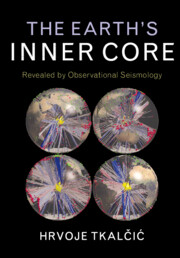Book contents
- Frontmatter
- Contents
- Preface
- Acknowledgements
- 1 On the History of Inner Core Discovery
- 2 Seismological Tools to Study the Inner Core
- 3 Inner Core Surface and Its Interior
- 4 Inner Core Anisotropy
- 5 Inner Core Rotational Dynamics
- 6 The Limitations, the Obstacles, and theWay Forward
- Appendix A Transmission/Reflection Coefficients for the Flat Inner Core Boundary
- Appendix B The Angle Between PKIKP Waves and the Rotation Axis of the Earth
- Appendix C P-Wave Velocity in a Transversely Isotropic Inner Core
- Appendix D Transdimensional Bayesian Inversion
- References
- Index
- Plate section
3 - Inner Core Surface and Its Interior
Published online by Cambridge University Press: 26 January 2017
- Frontmatter
- Contents
- Preface
- Acknowledgements
- 1 On the History of Inner Core Discovery
- 2 Seismological Tools to Study the Inner Core
- 3 Inner Core Surface and Its Interior
- 4 Inner Core Anisotropy
- 5 Inner Core Rotational Dynamics
- 6 The Limitations, the Obstacles, and theWay Forward
- Appendix A Transmission/Reflection Coefficients for the Flat Inner Core Boundary
- Appendix B The Angle Between PKIKP Waves and the Rotation Axis of the Earth
- Appendix C P-Wave Velocity in a Transversely Isotropic Inner Core
- Appendix D Transdimensional Bayesian Inversion
- References
- Index
- Plate section
Summary
“Because the modes of group 2 would have zero energy in the inner core if it were liquid, the only way to increase their eigenfrequencies would be to increase the bulk modulus in the outer core, a condition contradicting that necessary to satisfy the data of group 1. We therefore conclude that solidity of the inner core represents the only solution consistent with the observations of normal modes.”
Adam M. Dziewoński & Freeman Gilbert (Dziewoński and Gilbert, 1971)Introduction to Studies of the IC Surface and Its Interior
A simple glance at a tomogram derived through use of modern imaging techniques reveals a stunning variety of features within the Earth's interior. Some local and regional studies of the Earth's crust use the portion of the seismic wavefield with wavelengths of several kilometres, while other, usually global, studies concentrate on wavelengths that exceed hundreds or even thousands of kilometres. When the focus of study is shifted to larger depths, images of the deep Earth's interior are often blurry, lacking the level of detail obtained nearer the Earth's surface. Tomography often does not extend to the Earth's core. If we were equipped with a toolset similar to that used for imaging near the Earth's surface, and if we were able to apply those tools to the well-mixed OC, the images would most likely reveal homogeneous seismological structure at long wavelengths. But what about the solid IC, which sits in its centre? The IC's radius is comparable in length to IC-sensitive long wavelength waveforms and normal modes, which are sensitive to IC structure only as part of an integral over the rest of the planet's radius. Yet, we have progressed significantly in understanding the physical appearance of the Earth's IC, not just at its surface, but also deep in its interior. Questions including how the IC appears at its surface, whether it has a rough or smooth boundary, whether it contains topography, how it solidifies and at what rate, what the density contrast at the OC boundary is, and how the IC texture changes with distance from the ICB have been the driving force behind many IC studies.
- Type
- Chapter
- Information
- The Earth's Inner CoreRevealed by Observational Seismology, pp. 38 - 73Publisher: Cambridge University PressPrint publication year: 2017
- 1
- Cited by



